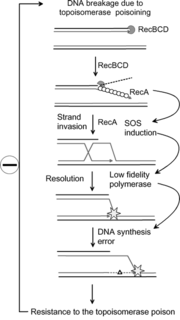
SOS response
Encyclopedia

Cell cycle
The cell cycle, or cell-division cycle, is the series of events that takes place in a cell leading to its division and duplication . In cells without a nucleus , the cell cycle occurs via a process termed binary fission...
is arrested and DNA repair
DNA repair
DNA repair refers to a collection of processes by which a cell identifies and corrects damage to the DNA molecules that encode its genome. In human cells, both normal metabolic activities and environmental factors such as UV light and radiation can cause DNA damage, resulting in as many as 1...
and mutagenesis are induced. The SOS uses the RecA
RecA
RecA is a 38 kilodalton Escherichia coli protein essential for the repair and maintenance of DNA. RecA has a structural and functional homolog in every species in which it has been seriously sought and serves as an archetype for this class of homologous DNA repair proteins...
protein (Rad51 in eukaryotes). The RecA protein, stimulated by single-stranded DNA, is involved in the inactivation of the LexA
Lexa
Lexa:* Lexa Pierce* Repressor lexA - Place name :* Lexa, Arkansas, a city in Phillips County, United StatesLexa means aborigional or native according to the dictionary.- Family name :* the House of Lexa , Lexa von Aehrenthal:...
repressor thereby inducing the response. It is an error-prone repair system.
During normal growth, the SOS genes are negatively regulated by LexA repressor protein dimers. Under normal conditions, LexA binds to a 20-bp consensus sequence (the SOS box
SOS box
SOS box is the region in the promoter of various genes to which the LexA repressor binds to repress the transcription in the absence of DNA damage.-Examples:See Nucleic acid nomenclature for an explanation of non-GATC nucleotide letters...
) in the operator region for those genes. Some of these SOS genes are expressed at certain levels even in the repressed state, according to the affinity of LexA for their SOS box. Activation of the SOS genes occurs after DNA damage by the accumulation of single stranded (ssDNA) regions generated at replication forks, where DNA polymerase
DNA polymerase
A DNA polymerase is an enzyme that helps catalyze in the polymerization of deoxyribonucleotides into a DNA strand. DNA polymerases are best known for their feedback role in DNA replication, in which the polymerase "reads" an intact DNA strand as a template and uses it to synthesize the new strand....
is blocked. RecA forms a filament around these ssDNA regions in an ATP-dependent fashion, and becomes activated. The activated form of RecA interacts with the LexA repressor to facilitate the LexA repressor's self-cleavage from the operator.
Once the pool of LexA decreases, repression of the SOS genes goes down according to the level of LexA affinity for the SOS boxes. Operators that bind LexA weakly are the first to be fully expressed. In this way LexA can sequentially activate different mechanisms of repair. Genes having a weak SOS box (such as lexA, recA, uvrA, uvrB, and uvrD) are fully induced in response to even weak SOS-inducing treatments. Thus the first SOS repair mechanism to be induced is nucleotide excision repair
Nucleotide excision repair
Nucleotide excision repair is a DNA repair mechanism. DNA constantly requires repair due to damage that can occur to bases from a vast variety of sources including chemicals, radiation and other mutagens...
(NER), whose aim is to fix DNA damage without commitment to a full-fledged SOS response.
If, however, NER does not suffice to fix the damage, the LexA concentration is further reduced, so the expression of genes with stronger LexA boxes (such as sulA, umuD, umuC - these are expressed late) is induced. SulA stops cell division
Cell division
Cell division is the process by which a parent cell divides into two or more daughter cells . Cell division is usually a small segment of a larger cell cycle. This type of cell division in eukaryotes is known as mitosis, and leaves the daughter cell capable of dividing again. The corresponding sort...
by binding to FtsZ, the initiating protein in this process. This causes filamentation
Filamentation
Filamentation is the anomalous growth of certain bacteria, such as E. coli, in which cells continue to elongate but do not divide . Bacterial filamentation is often observed as a result of bacteria responding to various stresses, including DNA damage or inhibition of replication...
, and the induction of UmuDC-dependent mutagenic repair. As a result of these properties, some genes may be partially induced in response to even endogenous levels of DNA damage, while other genes appear to be induced only when high or persistent DNA damage is present in the cell.
Antibiotic resistance
Recent research has shown that the SOS pathway may be essential in the acquisition of bacterial mutations which lead to resistanceAntibiotic resistance
Antibiotic resistance is a type of drug resistance where a microorganism is able to survive exposure to an antibiotic. While a spontaneous or induced genetic mutation in bacteria may confer resistance to antimicrobial drugs, genes that confer resistance can be transferred between bacteria in a...
to some antibiotic drugs. The increased rate of mutation during the SOS response is caused by three low-fidelity DNA polymerase
DNA polymerase
A DNA polymerase is an enzyme that helps catalyze in the polymerization of deoxyribonucleotides into a DNA strand. DNA polymerases are best known for their feedback role in DNA replication, in which the polymerase "reads" an intact DNA strand as a template and uses it to synthesize the new strand....
s: Pol II, Pol IV and Pol V. Researchers are now targeting these proteins with the aim of creating drugs that prevent SOS repair. By doing so, the time needed for pathogenic bacteria to evolve antibiotic resistance could be extended, and thus improve the long term viability of some antibiotic drugs.

